
myCBSEguide App
Download the app to get CBSE Sample Papers 2023-24, NCERT Solutions (Revised), Most Important Questions, Previous Year Question Bank, Mock Tests, and Detailed Notes.
Install NowCBSE Biology Chapter 14 Respiration in Plants class 11 Notes Biology in PDF are available for free download in myCBSEguide mobile app. The best app for CBSE students now provides Respiration in Plants class 11 Notes Biology latest chapter wise notes for quick preparation of CBSE exams and school based annual examinations. Class 11 Biology notes on Chapter 14 Respiration in Plants class 11 Notes Biology are also available for download in CBSE Guide website.
CBSE Guide Respiration in Plants class 11 Notes
CBSE guide notes are the comprehensive notes which covers the latest syllabus of CBSE and NCERT. It includes all the topics given in NCERT class 11 Biology text book. Users can download CBSE guide quick revision notes from myCBSEguide mobile app and my CBSE guide website.
Respiration in Plants class 11 Notes Biology
Download CBSE class 11th revision notes for Chapter 14 Respiration in Plants class 11 Notes Biology in PDF format for free. Download revision notes for Respiration in Plants class 11 Notes Biology and score high in exams. These are the Respiration in Plants class 11 Notes Biology prepared by team of expert teachers. The revision notes help you revise the whole chapter in minutes. Revising notes in exam days is on of the best tips recommended by teachers during exam days.
Download Revision Notes as PDF
CBSE Quick Revision Notes
CBSE Class-11 Biology
CHAPTER-14
Respiration in Plants class 11 Notes Biology
Respiration is an energy releasing, enzymatically controlled catabolic process which involves a step-wise oxidative breakdown of food substance inside living cells.
- Living organism require energy for all activities like absorption, movement, reproduction or even breathing. Energy required is obtained from oxidation of food during respiration.
- Cellular respiration is the mechanism of breaking down of food materials within the cell to release energy for synthesis of ATP.
- Breaking down of complex molecules takes place to produce energy in cytoplasm and in the mitochondria.
- Breaking down of C-C bond of complex compounds through oxidation within the cells leading to release of energy is called respiration. The compounds that get oxidized are called respiratory substrates.
- Energy released during oxidation is not used directly but utilized in synthesis of ATP, which is broken down when energy is required. Therefore, ATP is called energy currency of cells.
- The process of respiration requires oxygen. In plants oxygen is taken in by stomata, lenticels and root hairs.
- Plants can get along without respiratory organs because:
- Each plant part takes care of its own gas-exchange needs.
- Plants do not present great demands for gas exchange.
- Distance that gases must diffuse in large plant is not great.
- During photosynthesis O2 is released in leaves and diffuse to other part of leaves.
- During process of respiration oxygen is utilized and carbon dioxide and water is released along with energy molecules in form of ATP.
- Respiratory Quotient is the ratio of the volume of carbon dioxide produced to the volume of oxygen consumed in respiration over a period of time. RQ is equal to one for carbohydrate and less than one for protein and peptones.


Aerobic Respiration is an enzymatically controlled release of energy in a stepwise catabolic process of complete oxidation of organic food into carbon dioxide and water with oxygen acting as terminal oxidant.
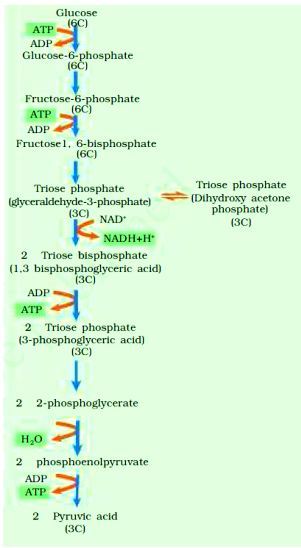
Glycolysis
- The scheme of glycolysis is given by Gustav Embden, Otto Meyerhof, and J. Parnas. It is also called as EMP pathway.
- Glycolysis is the partial oxidation of glucose or similar hexose sugar into two molecules of pyruvic acid through a series of enzyme mediated reaction releasing some ATP and NADH2. It occurs in cytoplasm.
- In plants glucose is derived from sucrose or from storage carbohydrates. Sucrose is converted into glucose and fructose by enzyme invertase.
- Glycolysis starts with phosphorylation of glucose in presence of enzyme hexokinase to form Glucose-6-phosphate. One molecules of ATP is used in this process.
- In next steps Glucose-6-phosphate is converted into fructose-6-phosphate, catalysed by enzyme phosphohexose isomerase.
- Fructose-6-phosphate uses another molecule of ATP to form Fructose-1-6 biphospahte in presence of enzyme phosphfructokinase.

- In glycolysis two molecules of ATP are consumed during double phosphorylation of glucose to fructose 1,6 biphosphate. Two molecules of NADPH2 are formed at the time of oxidation of glyceraldehyde 3-phosphate to 1,3 biphosphoglycerate. Each NADH is equivalent to 3ATP, so that net gain in glycolysis is 8 ATP.
- Pyruvic acid is the key product of glycolysis, further breakdown of pyruvic acid depends upon the need of the cell.
- In animal cells, like muscles during exercise, when oxygen is insufficient for aerobic respiration, pyruvic acid is reduced to Lactic acid by enzyme lactate dehydrogenase due to reduction by NADH2.
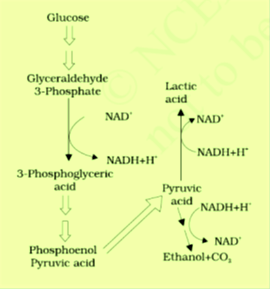
- In fermentation by yeast, pyruvic acid is converted to ethanol and CO2. The enzyme involved is pyruvic acid decarboxylase and alcohol dehydrogenase catalyse this reaction.
- In both lactic acid fermentation and alcohol fermentation very less amount of energy is released.
- Yeasts poison themselves to death if concentration of alcohol reaches above 13%.
- Final product of glycolysis, pyruvate is transported from the cytoplasm into mitochondria for further breakdown.
- Oxidation of Pyruvate to Acetyl-CoA is done to produce CO2 and NADH. The reaction catalyzed by pyruvic dehydrogenase requires the participation of several Coenzymes including NAD+ .
- The Acetyl CoA enters a cyclic pathway called TCA cycle or Kreb’s cycle.
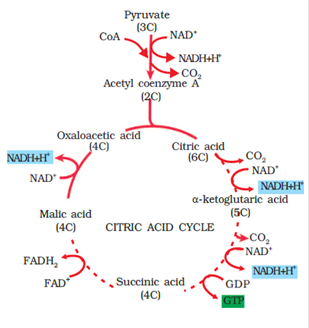
Tricarboxylic Acid Cycle/Krebs Cycle
- TCA cycle was discovered by Hans Krebs in 1940. This cycle is called TCA cycle because initial product is citric acid.
- Acetyl CoA combine with OAA ( Oxaloacetic acid) and water to yield citric acid in presence of enzyme citrate synthase to release CoA.
- Citrate is then isomerised to isocitrate. It is followed by two successive
steps of decarboxylation, leading to the formation of α-ketoglutaric acid and then succinyl-CoA. - In the remaining steps, succinyl-CoA is oxidised to OAA allowing the cycle to continue.
- There are three points in the cycle where NAD + is reduced to NADH2 and one point where FAD + is reduced to FADH2 .
- A molecule of glucose produces two molecules of , 2ATP and two pyruvate while undergoing glycolysis. The two molecules of pyruvate are completely degraded in Krebs cycle to form two molecules of ATP, and .
pyruvic + 4NAD+ + FAD+ + 2H2O + ADP + Pi 3CO2
Terminal Oxidation is the name of oxidation found in aerobic respiration that occurs towards end of catabolic process and involves the passage of both electrons and protons of reduced coenzyme to oxygen to produce water.
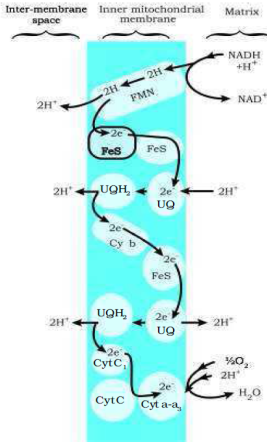
Electron Transport Chain
- The metabolic pathway through which the electron passes from one carrier to another inside the inner mitochondrial membrane is called ETC or mitochondrial respiratory chain.
- Electrons from NADH produced during citric acid cycle are oxidized by NADH dehydrogenase and electrons are transferred to ubiquinone located within the inner membrane. Ubiquinone also receives electrons from FADH2 which is transferred to cytochrome c via cytochrome bc1 complex.
- When the electrons pass from one carrier to another via electron transport chain, they produce ATP from ADP and inorganic phosphate. The number of ATP molecules synthesized depends upon electron donor.
- Oxidation of one molecule of NADH gives rise to 3 molecules of ATP, while oxidation of one molecule of produce two molecules of ATP.
| Oxidative phosphorylation | Photophosphorylation |
| a) It occurs in respiration process. b) Energy of oxidation-reduction is used for production of proton gradient required for phosphorylation. | a) It occurs in photosynthesis. b) Light energy is utilized for production of proton gradient for phosphorylation. |
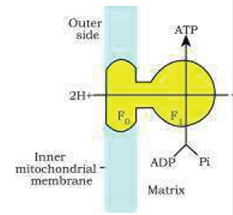
- The energy released during ETC is used to make ATP with the help of ATP synthase, which consists of two major parts F1 and F0.
- F1 is a peripheral membrane protein complex having site for synthesis of ATP from ADP and inorganic phosphate. F0 is integral membrane protein that form channel for proton.
- For each ATP produced 2H+ passes through F0 from the intermembrane space to the matrix down the electrochemical proton gradient.
| Fermentation | Aerobic Respiration |
| a. It accounts for incomplete oxidation of glucose. b. In fermentation, there is net gain of only two molecules of ATP. c. NADH is oxidized to NAD+ very slowly. | a. It accounts for complete oxidation of glucose. b. In aerobic respiration, there is more net gain of ATP. c. NADH is oxidized to NAD+ very fast. |
Amphibolic Pathway
- Glucose is the favored substrate for respiration. All carbohydrates are usually converted into glucose before used for respiration.
- Fats needs to be broken down into glycerol and fatty acid, which is further broken converted into Acetyl CoA and enter the respiratory pathway.
- Proteins are broken into amino acids and further enter into Krebs cycle.
- Breaking down process within living organism is called catabolism and synthesis process is called anabolism process. So, respiration is an Amphibolic pathway.
Respiration in Plants class 11 Notes
- CBSE Revision notes (PDF Download) Free
- CBSE Revision notes for Class 11 Biology PDF
- CBSE Revision notes Class 11 Biology – CBSE
- CBSE Revisions notes and Key Points Class 11 Biology
- Summary of the NCERT books all chapters in Biology class 11
- Short notes for CBSE class 11th Biology
- Key notes and chapter summary of Biology class 11
- Quick revision notes for CBSE exams
CBSE Class-11 Revision Notes and Key Points
Respiration in Plants class 11 Notes Biology. CBSE quick revision note for class-11 Mathematics, Physics, Chemistry, Biology and other subject are very helpful to revise the whole syllabus during exam days. The revision notes covers all important formulas and concepts given in the chapter. Even if you wish to have an overview of a chapter, quick revision notes are here to do if for you. These notes will certainly save your time during stressful exam days.
- Revision Notes for class-11 Physics
- Revision Notes for class-11 Chemistry
- Revision Notes for class-11 Mathematics
- Revision Notes for class-11 Biology
- Revision Notes for class-11 Accountancy
- Revision Notes for class-11 Economics
- Revision Notes for class-11 Business Studies
- Revision Notes for class-11 Computer Science
- Revision Notes for class-11 Informatics Practices
- Revision Notes for class-11 Geography
To download Respiration in Plants class 11 Notes, sample paper for class 11 Chemistry, Physics, Biology, History, Political Science, Economics, Geography, Computer Science, Home Science, Accountancy, Business Studies and Home Science; do check myCBSEguide app or website. myCBSEguide provides sample papers with solution, test papers for chapter-wise practice, NCERT solutions, NCERT Exemplar solutions, quick revision notes for ready reference, CBSE guess papers and CBSE important question papers. Sample Paper all are made available through the best app for CBSE students and myCBSEguide website.
- The Living World class 11 Notes Biology
- Biological Classification class 11 Notes Biology
- Plant Kingdom class 11 Notes Biology
- Animal Kingdom class 11 Notes Biology
- Morphology of Flowering Plants class 11 Notes Biology
- Anatomy of Flowering Plants class 11 Notes Biology
- Structural Organisation in Animals class 11 Notes Biology
- Cell Structure and Functions class 11 Notes Biology
- Biomolecules class 11 Notes Biology
- Cell Cycle and Cell Division class 11 Notes Biology
- Transport in Plants class 11 Notes Biology
- Mineral Nutrition class 11 Notes Biology
- Photosynthesis in higher plants class 11 Notes Biology
- Respiration in Plants class 11 Notes Biology
- Plant Growth and Development class 11 Notes Biology
- Digestion And Absorption class 11 Notes Biology
- Breathing and Exchange of Gases class 11 Notes Biology
- Body Fluids And Circulation class 11 Notes Biology
- Excretory Products and their Elimination class 11 Notes Biology
- Locomotion and Movement class 11 Notes Biology
- Neural Control and Coordination class 11 Notes Biology
- Chemical Coordination and Integration class 11 Notes Biology
- Cell Structure and Functions class 11 Notes Biology

Test Generator
Create question paper PDF and online tests with your own name & logo in minutes.
Create Now
myCBSEguide
Question Bank, Mock Tests, Exam Papers, NCERT Solutions, Sample Papers, Notes
Install Now
Nice
Your notes really help me to understand ncert easily. Thank you!